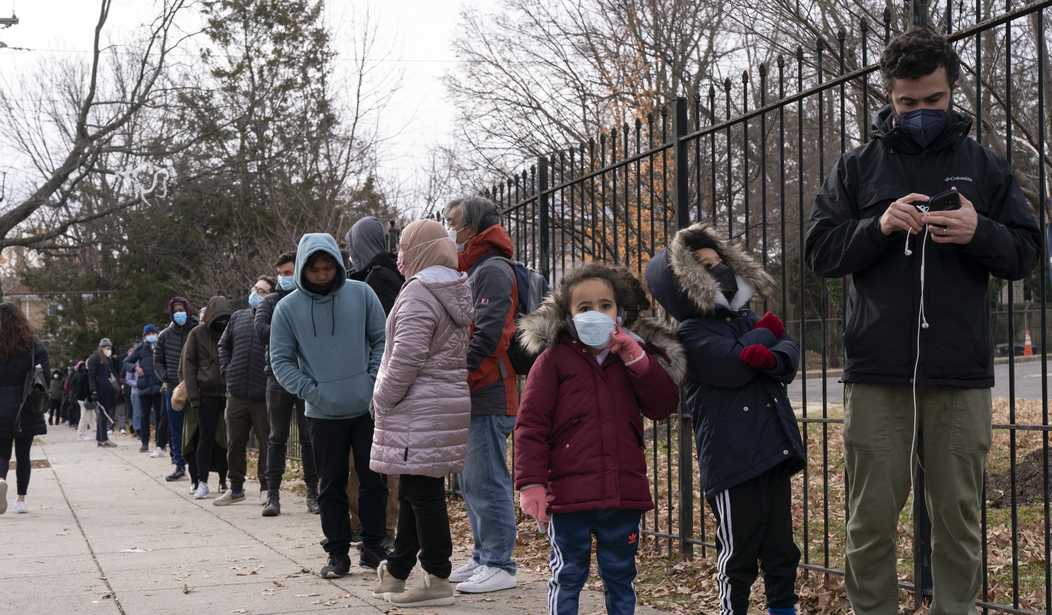We’ve seen hints that the Omicron wave could peak early and decline rapidly. In South Africa, that’s exactly what happened, but that was in a younger and less overweight population. The UK’s Omicron wave appeared to have begun a sharp decline last week.
Is it our turn? Last night, the Washington Post reported that the signs look good in major metropolitan areas, especially in New York City:
The explosion of omicron cases along the Interstate 95 corridor from the Mid-Atlantic to New England is showing signs of slowing down, according to health officials and epidemiologists, offering reason for cautious optimism that the turning point could be near and that the coronavirus variant’s U.S. trajectory is similar to that of other countries.
New York Gov. Kathy Hochul (D) said Tuesday the rates of tests returning positive and case increases seem to be slowing — particularly in New York City, which emerged as an early epicenter of the highly contagious variant.
“They’re still high, but we are not at the end, but I want to say that this is, to me, a glimmer of hope, a glimmer of hope in a time when we desperately need that,” Hochul said at a news conference.
Just how reliable are these test measures in an environment where few people can access tests, though? The Omicron wave burned through the thin stock of tests that we do have, and now people are either taking a pass entirely on tests or flooding ERs to get to them, usually while either asymptomatic or with symptoms that don’t require medical attention. With a testing gap this wide, can we really measure how far along the wave we truly are?
Actually, yes, albeit somewhat indirectly:
Coronavirus levels in Boston-area wastewater are falling, a promising sign because alarmingly high levels spotted earlier presaged record infections. The Children’s Hospital of Philadelphia has seen the rate of teachers testing positive during asymptomatic weekly screening plunge from 25 percent in the week between Christmas and New Year’s to 2 percent in recent days.
Wastewater testing doesn’t get many headlines, but it has proven pretty good at picking up on trendlines before they appear in official statistics. Which in this case is comforting, because the CDC’s official data doesn’t suggest that we’ve hit the peak, especially with the limited testing available:

There could be a number of reasons both could be true — that we’re still seeing cases climb nationwide while seeing a drop on the Atlantic seaboard. We are a large nation in both population and geography, and as we have seen in this pandemic, waves are best considered regionally. A dramatic drop on the Acela corridor would still be great news, since it has been the leading edge for COVID-19 waves, as it would portend short waves everywhere else.
The New York Times’ David Leonhardt calls for cautious optimism that we may see the light at the end of the Omicron tunnel sooner than expected. And with it, perhaps the emergence of a population that no longer has a novel immunity posture to COVID-19:
As Doron suggested, it’s too early to be confident that the Omicron wave has peaked even in areas with encouraging data — which tend to be the places where Omicron first arrived in the U.S. But there is good reason to consider that the most likely scenario. “Looks like we may be cresting over that peak,” Gov. Kathy Hochul of New York said this week.
A huge surge in cases that lasts for about one month, followed by a rapid decline, would be consistent with the experience in some places where Omicron arrived earlier than in the U.S. In South Africa, new daily cases have fallen by about 70 percent from the mid-December peak. The chart showing South Africa’s recent trend looks like a skinny, upside-down letter V.
In Britain, where pandemic trends have frequently been a few weeks ahead of those in the U.S., cases peaked just after New Year’s and have since fallen somewhat …
Still, the beginning of the end of the Omicron wave — if it turns out to be real — would be very good news.
It would mean that a milder variant had become the dominant form of Covid but was no longer causing a surge in cases and overwhelming hospitals. It would mean that tens of millions of Americans had built up additional immunity, as a result of an Omicron infection. It would mean that the country would have taken a big step toward a future in which Covid is an endemic disease like the flu, rather than a pandemic that dominates life.
Leonhardt has done good work in covering COVID-19 rationally and realistically. This final point sounds like more wisdom. Omicron exposure is all but inevitable at this point, and its ability to puncture immunity to provide hosts for replication — if not acute infections — means that everyone will eventually acquire it at some point. With that in mind, serious drops in wastewater and in test results signal that the variant might have run out of unexposed hosts in most areas, with transmission declining exponentially as the number of unexposed keeps shrinking. That means most if not all Americans will come out the other side with some immune response regardless of vaccination status, with the vaccinated even stronger.
The question is how much longer we have to wait to get there, and whether our hospitals and clinics can hold up under that utilization spike. And when we will get back to rational risk-balancing and stop telling asymptomatic people to isolate themselves in an environment where almost 80% of the ≥5YO population is already vaccinated.







Join the conversation as a VIP Member